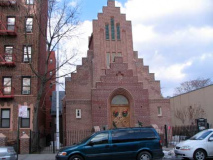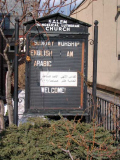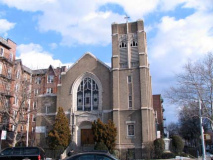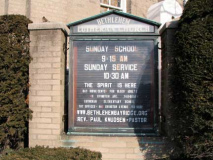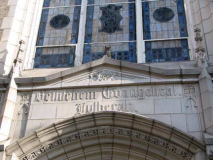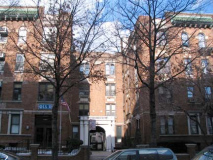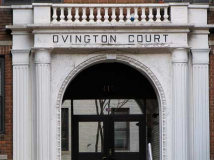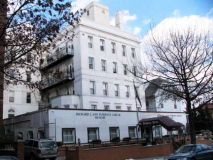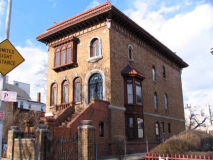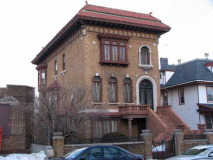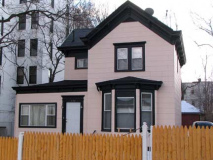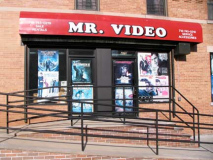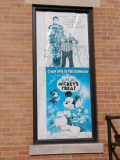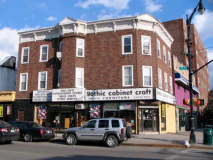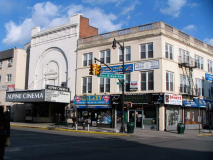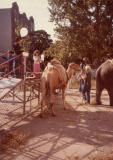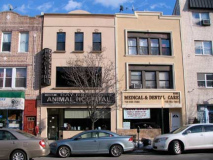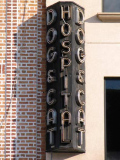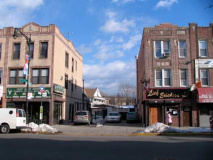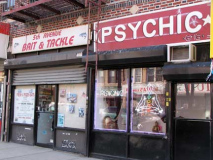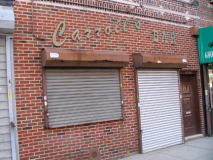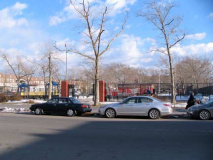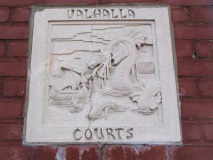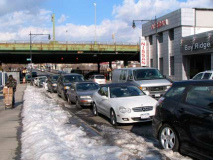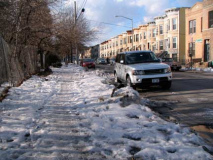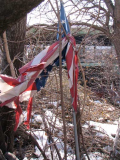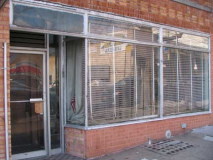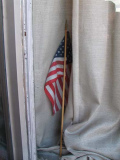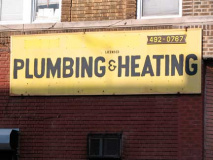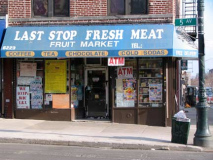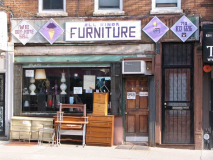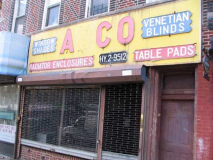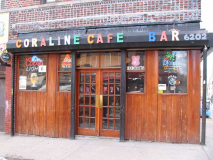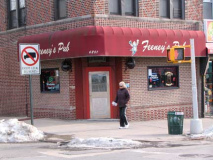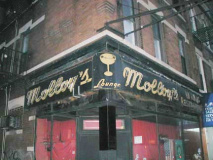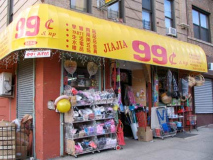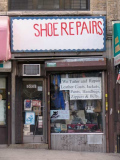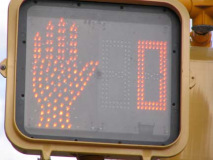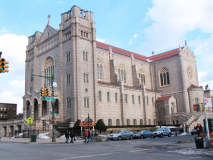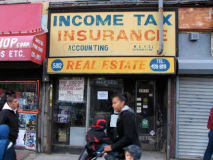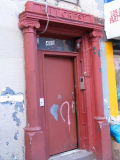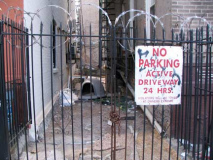John Masefield famously wrote, I must go down to the seas again, and I am also a creature of habit — I am drawn to certain areas over and over, though I remain steadfast in my desire to eventually describe every neighborhood and subneighborhood in New York City to the last detail. I was at the dentist yet again getting a crown fitted, then lunch at Zeke’s Roast Beef on 3rd Avenue, and then there was the rest of the afternoon to fill, so I stalked down Ovington and then a stretch of Fifth that I have thus far given short shrift. (That rhymes, kind of). I previously handled 5th Avenue, Brooklyn, in depth in October 2006 from Green-Wood Cemetery to Atlantic Avenue. I must have been up and down 5th thousands of times, since I rode the B63 bus as a kid and well into my twenties to travel back and forth from St. Francis College and then a job at the NY Business Library.
The Salem Evangelical Lutheran Church, Ovington between 3rd and 4th Avenues, bears two cornerstones, 1899 and 1941, denoting the founding of the congregation and the date of the church’s construction. The stepped arrangement harkens back to the Flemish style of the Dutch colonial period. The church bears one of those old decrepit signboards I’m always so fond of.
Looks like I got here at the right time. This, the first Arabic church in the USA, will soon be demolished (February ’11)
The Bethlehem Lutheran Church at 4th and Ovington (3 photos on right) bears some handsome stained glass and terra cotta work.
The present Bethlehem Lutheran Church building was constructed between 1922 and 1930. The church was designed by Koch & Wagner (32 Court Street, Brooklyn), one of New York’s most prominent architecture firms — the designers of the landmark Ralph Bunche House, numerous public buildings and banks, and parts of the Cathedral of St. John the Divine in Manhattan.
Bethlehem’s church is of English Gothic design throughout, with an interior space richly decorated and trimmed with polished oak. The exterior dimensions are 90 by 50 feet. It has a massive tower rising to a height of 75 feet and is built of gray tapestry brick ornamented with terra cotta trim. Bethlehem Bay Ridge
Catercorner across 4th Avenue was formerly the great 1899 Bay Ridge United Methodist Church, a.k.a. the “Green Church.” It was sold and razed in 2008.
Ovington Court is one of those huge apartment buildings with inner courtyards Bay Ridge is known for.
Ovington Avenue is one of Bay Ridge’s oldest cross streets, and it meanders gently against the grid that was later laid down around it, so it was never assigned a number. The Ovington family farm was located in the area since just after the colonial era; a group of artists and artisans purchased the farm in the 1850s, calling it Ovington Village, and Ovington Avenue was the road between the Athenaeum (concert hall) and the village. It was later built up and lined with spacious homes on 400-foot-wide plots. Family scion Mary White Ovington helped found the NAACP.
Some of Ovington Avenue’s variegated architecture between 4th and 5th Avenues: the St. Nicholas Home (left), a residence for the elderly formerly a nurses’ training school; the spook house of Ovington, 457 (center two), which looks as inscrutable and impenetrable as it did the first time I photographed it in 2007, at which time it looked exactly the same as it did when I passed it by every day in the 1980s; and 456 (right) , which looks like a former farmhouse.
Mr. Video at the NW corner of 5th and Ovington was Galaxy Video in the 1980s, when I was a member (I still have the photo membership card to prove it). Even earlier, my father shot come camels and elephants (with a camera!) part of a 1980s street fair (photo right).
Cinema history displayed in the windows: Deck the Halls (2006), Mickey’s Treat (2007)
Gothic Cabinet Craft (center) has inhabited this 1910s-era building at Ovington and 5th for as long as I can remember, back into the Super 70s.
As a kid, and well into adulthood, I had my pick of movie theatres in Bay Ridge: The Dyker (86th and Gelston), the Harbor (4th and 93rd), the Fortway (Fort Hamilton Parkway and 68th Street) and the Alpine (5th and Bay Ridge Avenue, or as we all referred to it, 69th Street). I took in most pictures at the Dyker, closest to my home, but I notably caught Planet of the Apes and its sequel Beneath The Planet of the Apes at the Harbor and Yellow Submarine here at the Alpine, which is now a ten-plex (deca-plex?) and is now the only game in town for Bay Ridge cine-philes. The theatre opened June 6, 1921 and it, too, was due for demolition or redevelopment before it was purchased by Nick Nicolaou, renovated and reopened in 2008.
For many years the corner store was held down by Nielsen Furniture, where my parents purchased many pieces throughout the years.
The Bay Ridge Animal Hospital, still with a 1940s-era neon sign, 5th Avenue between 68th and 69th Streets, In The Things You Remember department, I recall that the building on the extreme right in the picture has a country-western venue on the ground floor, and one of the acts in the early 1970s was…Bud Harrelson, the noted Met shortstop and guitar player.
Where Senator Street meets 5th Avenue, it continues east just a little further south on 5th, but there’s a break between buildings here, as if Senator Street used to run through. It never did: this is the beginnings of a lost Brooklyn road called Kouwenhoven Lane, which zigged and zagged through today’s Bay Ridge, Dyker Heights and Borough Park, ending at about today’s 18th Avenue and 55th Street. It can be seen, if you look hard for it, on this 1873 map of the town of New Utrecht, of which Bay Ridge was a part.
Next to Kouwenhoven Lane is the Lief Ericson tavern, named for one of the Scandinavian explorers who happened upon the North American continent around the beginning of the 11th Century. Incongruously an Irish flag hangs outside.
On the west side of 5th between Senator and 67th you have the opportunity to buy some chum and then find out how the fish are biting in the Narrows. Carroll’s Bar has been here, with this sign, for atl least 50 years.
Lief Ericson Square is a corridor park between 66th and 67th Streets and 4th Avenue and Fort Hamilton Parkway, named for the famed explorer. Some of the park sections are green and verdant, but this is a somewhat boring section with basketball courts and playfields. Interestingly, the basketball courts, the Valhalla Courts, are named for the Norse version of heaven. The bas relief shows a sea monster devouring a sea monster-shaped Viking vessel. This is like showing your webmaster devouring a webmaster-shaped pizza.
Looking toward 65th Street, over which runs the Gowanus Expressway, the ramp to the Verrazano Bridge, constructed between 1959 and 1964. It appears the structure needs a paint job. Right: the city does not apparently have the funds, or the will, to clear the sidewalk on 64th Street adjoining the Bay Ridge LIRR cut on 64th Street near 5th a good 3 weeks after the latest blizzard [the winter of 2010-2011 was a harsh one].
Old Glory, though tattered and abandoned, illuminates 5th Avenue and 64th Street.
I have always been fascinated with these seemingly abandoned storefronts, and the perhaps illicit activities that go on in back of the blinds.
5th Avenue between the railroad and Our Lady of Perpetual Help Church on 60th Street is in transition, neither Bay Ridge nor Sunset Park…
Hand-lettered sign, 5th Avenue and 63rd Street. Right: across the street: this may well be your last opportunity to get fresh meat on 5th Avenue as you head north into Sunset Park, but who knows.
Several fascinating hand-lettered or hand carved signs along this stretch, like the diamonds on the All Kinda Furniture store, or the plastic letters, some of which have fallen off, on the ABCO window treatment place.
You can tell this sign is straight from the Swingin’ Sixties from the phone exchange. The HY stood for HYacinth.
My favorite was the wood-panelled Coraline Cafe at 5th and 62nd street, with its multicolored woodcut lettering.
Across the street is Feeney’s Pub, with a rather mundane vinyl or plastic awning sign. The sign was much richer in arcane neon when this was Molloy’s Lounge. The old sign is likely still under there.
In February 2011, Mayor Bloomberg got in a spot when he implied that the Irish are a cadre of staggering drunks, but there’s always a kernel of truth beneath every joke and in some sections of 5th there’s a bar on every corner — perhaps more than one corner per intersection.
Center: a Chinese incursion into Sunset Park, as Chinatown is a good three avenues over, on 8th Avenue. 99¢ places and mom and pop shoe shine palaces are increasingly unwelcome in the Bloomberg World of Walmarts, Targets and Starbucks.
Speaking of drunks, the guy who made up this sign over the shoe repair place (second from right) appeared to be half in the bag when he lettered it. At least he got both words in before he reached the edge of the sign.
And now, on with the countdown at 60th and 5th. As Casey Kasem would say, keep your feet on the ground but keep reaching for the stars. And be on the sidewalk by zero, for Pete’s sake.
What we really need are stoplights that count down to the green, so we can find out how long we have to wait in the brutal winter wind for the light to change.
Our Lady of Perpetual Help Roman Catholic Church is a cathedral in all but name, a magnificent religious palace occupying most of the block between 59th and 60th Streets and 5th and 6th Avenues. It occupies a crest in the topography (though not as high as the one Sunset Park is on about 15 blocks north of here). The church was accorded basilica status in 1969, though it is not yet a cathedral (the church where a bishop serves). The parish has been in existence since 1893, while the church building itself was built in the mid-1920s. In the 1940s and 1950s one of the parishioners and altar boys was future major league baseball player, then actor, Chuck Connors.
At the time of its completion, the parish was largely Irish in character (as evidenced by the inscriptions on the memorial windows). It was built on what was known as Irish Hill. Some of the family names include Collins, Brennan, Wade, Connors, Burns, McCaffrey, Healy, and Coffey. There is still an Irish presence, but today it is predominantly Hispanic and Chinese. The Basilica enjoys large attendance, particularly on holidays such as Ash Wednesday, Palm Sunday and Christmas. wikipedia
Right three: Yet one more hand lettered sign opposite the church on 5th Avenue. Right: the name over the door on 59th Street reflects the topography. And I wouldn’t THINK of parking there.


